Understanding Shoe Boils in Horses
Shoe boils, also known as olecranon bursitis or capped elbows, occur when repeated trauma to a horse’s elbow causes swelling, irritation, and sometimes fibrous thickening of the bursa—a fluid-filled sac that cushions the joint.
If left untreated, shoe boils can lead to discomfort, reduced mobility, and, in severe cases, infection. The good news? With early intervention and proper preventive care, you can manage and even prevent shoe boils effectively.
Causes of Shoe Boils in Horses
Shoe boils develop due to repeated pressure or impact on the horse’s elbow. The most common causes include:
- Hoof or Shoe Contact – When a horse lies down, the heel of its hoof or shoe can rub against the elbow, causing trauma.
- Hard Stall Floors – Horses lying on rough, hard, or thinly bedded surfaces are more prone to elbow irritation.
- Frequent Lying Down – Older horses, larger breeds, or horses recovering from injuries tend to lie down more often, increasing their risk.
- Ill-Fitted or Overgrown Shoes – Shoes with long heels or sharp edges can exacerbate pressure against the elbow.
Recognizing the Symptoms of Shoe Boils
Early detection is crucial to prevent complications. Look for:
- Soft swelling or lump behind the elbow
- Tenderness or irritation when touched
- Skin thickening or hair loss over time
- Fluid-filled sac that may harden if untreated
- Signs of infection such as heat, redness, or discharge
If you notice these signs, acting quickly can prevent the need for surgical intervention.

Shoe Boil Treatment: How to Heal & Manage Olecranon Bursitis
The key to treating shoe boils is preventing further trauma while reducing swelling and discomfort. Here’s how:
1️⃣ Protect the Elbow with a Shoe Boil Boot
The Monster Shoe Boil Boot is an essential tool for preventing and treating shoe boils. Designed with durable padding, this boot creates a protective barrier between the hoof and the elbow, reducing impact and irritation.
Shop the Monster Shoe Boil Boot here: Monster Horse Products
2️⃣ Improve Stall Bedding
Deep, cushioned bedding (such as shavings, straw, or rubber mats) reduces pressure on the elbows when lying down. Ensure stalls are well-maintained and free from hard surfaces.
3️⃣ Apply Cold Therapy
For recent or inflamed shoe boils, applying cold compresses or ice packs can help reduce swelling. Cold therapy is most effective in the first 48 hours after noticing a new lump.
4️⃣ Use Anti-Inflammatory Medications
Veterinarians may recommend Bute (phenylbutazone) or Banamine to control pain and inflammation. Always follow professional guidance when administering medications.
5️⃣ Consider Topical Treatments
Some horse owners find relief using topical DMSO (dimethyl sulfoxide) or antibacterial ointments to reduce swelling and promote healing.
6️⃣ Consult a Farrier for Shoeing Adjustments
If your horse’s shoeing contributes to elbow trauma, ask your farrier about trimming or rounding the heels to prevent contact with the elbow.
7️⃣ Drainage & Injections for Severe Cases
In chronic or severe cases, your veterinarian may:
- Drain excess fluid from the bursa
- Inject corticosteroids to reduce inflammation
- Prescribe antibiotics if infection is present
- Recommend surgical removal of the bursa if necessary
How to Prevent Shoe Boils in Horses
The best treatment is prevention! Here’s how to stop shoe boils before they start:
- Use Protective Gear – Invest in a Monster Shoe Boil Boot or padded ring boots to prevent trauma.
- Provide Deep Bedding – Keep stalls well-bedded to cushion elbows.
- Check Shoeing Regularly – Work with your farrier to adjust the heels of your horse’s shoes if needed.
- Monitor for Early Signs – Catching swelling early prevents long-term damage.
FAQs About Shoe Boil Treatment & Prevention
Can a shoe boil go away on its own?
Not usually. Shoe boils tend to worsen over time without intervention. Early treatment and protective gear can prevent complications.
Should I drain a shoe boil at home?
No! Draining a shoe boil without veterinary supervision can lead to infection. Always consult a vet before attempting any drainage.
What’s the best way to prevent shoe boils?
Using a Monster Shoe Boil Boot, ensuring deep bedding, and checking shoe fit regularly are the top prevention methods.
Final Thoughts: Keep Your Horse Comfortable & Healthy
Shoe boils are common but highly preventable with the right protective measures. Whether you’re treating an existing shoe boil or preventing one, Monster Horse Products offers premium protective gear designed to keep your horse comfortable and sound.
Shop for shoe boil boots & leg protection here: Monster Horse Products
Have questions? Contact us today!
